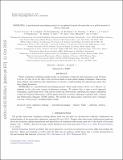Files in this item
ROME/REA : a gravitational microlensing search for exoplanets beyond the snow line on a global network of robotic telescopes
Item metadata
| dc.contributor.author | Tsapras, Yiannis | |
| dc.contributor.author | Street, Rachel A. | |
| dc.contributor.author | Hundertmark, Markus | |
| dc.contributor.author | Bachelet, Etienne | |
| dc.contributor.author | Dominik, Martin | |
| dc.contributor.author | Bozza, Valerio | |
| dc.contributor.author | Cassan, Arnaud | |
| dc.contributor.author | Wambsganss, Joachim | |
| dc.contributor.author | Horne, Keith Douglas | |
| dc.contributor.author | Mao, Shude | |
| dc.contributor.author | Zang, Weichen | |
| dc.contributor.author | Bramich, Daniel M. | |
| dc.contributor.author | Saha, Abhijit | |
| dc.date.accessioned | 2020-10-10T23:35:28Z | |
| dc.date.available | 2020-10-10T23:35:28Z | |
| dc.date.issued | 2019-12 | |
| dc.identifier | 261744312 | |
| dc.identifier | 70968596-5b42-4b19-954b-cd613fc27dd9 | |
| dc.identifier | 000503503700001 | |
| dc.identifier.citation | Tsapras , Y , Street , R A , Hundertmark , M , Bachelet , E , Dominik , M , Bozza , V , Cassan , A , Wambsganss , J , Horne , K D , Mao , S , Zang , W , Bramich , D M & Saha , A 2019 , ' ROME/REA : a gravitational microlensing search for exoplanets beyond the snow line on a global network of robotic telescopes ' , Publications of the Astronomical Society of the Pacific , vol. 131 , no. 1006 , 1244401 , pp. 1-12 . https://doi.org/10.1088/1538-3873/ab3b19 | en |
| dc.identifier.issn | 0004-6280 | |
| dc.identifier.other | ORCID: /0000-0002-3202-0343/work/75996775 | |
| dc.identifier.uri | https://hdl.handle.net/10023/20760 | |
| dc.description | Funding: KH acknowledges support from STFC grant ST/R000824/1. | en |
| dc.description.abstract | Planet population synthesis models predict an abundance of planets with semimajor axes between 1 and 10 au, yet they lie at the edge of the detection limits of most planet finding techniques. Discovering these planets and studying their distribution is critical to understanding the physical processes that drive planet formation. ROME/REA is a gravitational microlensing project whose main science driver is to discover exoplanets in the cold outer regions of planetary systems. To achieve this, it uses a novel approach combining a multiband survey with reactive follow-up observations, exploiting the unique capabilities of the Las Cumbres Observatory global network of robotic telescopes combined with a Target and Observation Manager system. We present the main science objectives and a technical overview of the project, including initial results. | |
| dc.format.extent | 12 | |
| dc.format.extent | 3066678 | |
| dc.language.iso | eng | |
| dc.relation.ispartof | Publications of the Astronomical Society of the Pacific | en |
| dc.subject | Galaxy: bulge | en |
| dc.subject | Gravitational lensing: micro | en |
| dc.subject | Methods: data analysis | en |
| dc.subject | Methods: observational | en |
| dc.subject | Planetary systems | en |
| dc.subject | QB Astronomy | en |
| dc.subject | QC Physics | en |
| dc.subject | DAS | en |
| dc.subject.lcc | QB | en |
| dc.subject.lcc | QC | en |
| dc.title | ROME/REA : a gravitational microlensing search for exoplanets beyond the snow line on a global network of robotic telescopes | en |
| dc.type | Journal article | en |
| dc.contributor.sponsor | Science & Technology Facilities Council | en |
| dc.contributor.institution | University of St Andrews. School of Physics and Astronomy | en |
| dc.contributor.institution | University of St Andrews. St Andrews Centre for Exoplanet Science | en |
| dc.identifier.doi | 10.1088/1538-3873/ab3b19 | |
| dc.description.status | Peer reviewed | en |
| dc.date.embargoedUntil | 2020-10-11 | |
| dc.identifier.grantnumber | ST/R00824/1 | en |
This item appears in the following Collection(s)
Items in the St Andrews Research Repository are protected by copyright, with all rights reserved, unless otherwise indicated.

